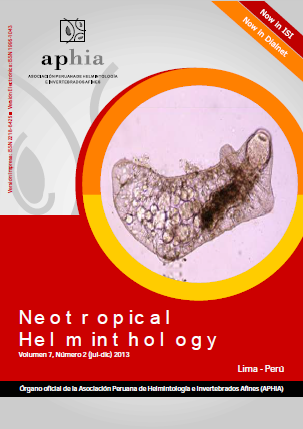DEVELOPMENT OF FASCIOLA HEPATICA AND ITS BIOTIC POTENTIAL IN RATTUS NORVEGICUS HOLTZMAN
DOI:
https://doi.org/10.24039/rnh201372983Keywords:
coproparasitological analysis, experimental animals, Fasciola, Rattus.Abstract
Fasciola hepatica is a digenean that has a complex life cycle which includes a vertebrate host in which its sexual reproduction occurs, verifiable in experimental animals. The objective of this study was to estimate the invasive power (PI), extension invasion (EI) and the biotic potential of this digenean in Rattus norvegicus albinus Holtzman strain, infected experimentally with F. hepatica's metacercariae which was obtained from infected snails in nature, in two provinces. Twenty metacercariae were administered in semisolid diet to six specimens of R. norvegicus, which were maintained in bioterio under controlled environmental conditions. We made coproparasitological analysis by simple concentration and sedimentation technique from the 86 to 100 days post infection and then proceeded with necropsies. We observed that the average production of eggs by adult F. hepatica was 9135.70 ± 2196.8, invasive power from 6.67 to 8.33% and the extent of invasion of 66.67% in R. norvegicus.
Downloads
Published
How to Cite
Issue
Section
License
Copyright (c) 2021 Neotropical Helminthology

This work is licensed under a Creative Commons Attribution-NonCommercial-NoDerivatives 4.0 International License.
OBJETO: El AUTOR-CEDENTE transfiere de manera TOTAL Y SIN LIMITACIÓN alguna al CESIONARIO los derechos patrimoniales que le corresponden sobre la (s) obra(s) tituladas: xxxxxxxxxxxxxxxx, por el tiempo que establezca la ley internacional. En virtud de lo anterior, se entiende que el CESIONARIO adquiere el derecho de reproducción en todas sus modalidades, incluso para inclusión audiovisual; el derecho de transformación o adaptación, comunicación pública, traducción, distribución y, en general, cualquier tipo de explotación que de las obras se pueda realizar por cualquier medio conocido o por conocer en el territorio nacional o internacional.
REMUNERACIÓN: La cesión de los derechos patrimoniales de autor que mediante este contrato se hace será a título gratuito.
CONDICIONES Y LEGITIMIDAD DE LOS DERECHOS: El AUTOR-CEDENTE garantiza que es propietario integral de los derechos de explotación de la(s) obra(s) y en consecuencia garantiza que puede contratar y transferir los derechos aquí cedidos sin ningún tipo de limitación por no tener ningún tipo de gravamen, limitación o disposición. En todo caso, responderá por cualquier reclamo que en materia de derecho de autor se pueda presentar, exonerando de cualquier responsabilidad al CESIONARIO.
LICENCIA DE ACCESO ABIERTO: El AUTOR-CEDENTE autoriza que manuscrito publicado en La Revista Neotropical Helminthology permanece disponible para su consulta pública en el sitio web https://www.neotropicalhelminthology.com/ y en los diferentes sistemas de indexación y bases de datos en las que la revista tiene visibilidad, bajo la licencia Creative Commons, en la modalidad Reconocimiento-No comercial- Sin Trabajos derivados –aprobada en Perú, y por lo tanto son de acceso abierto. De ahí que los autores dan, sin derecho a retribución económica, a la Asociación Peruana de Helmintología e Invertebrados Afines (APHIA), los derechos de autor para la edición y reproducción a través de diferentes medios de difusión.


 Numero 2 Volumen 19 - 2025 (versión Anticipada)
Numero 2 Volumen 19 - 2025 (versión Anticipada)














































